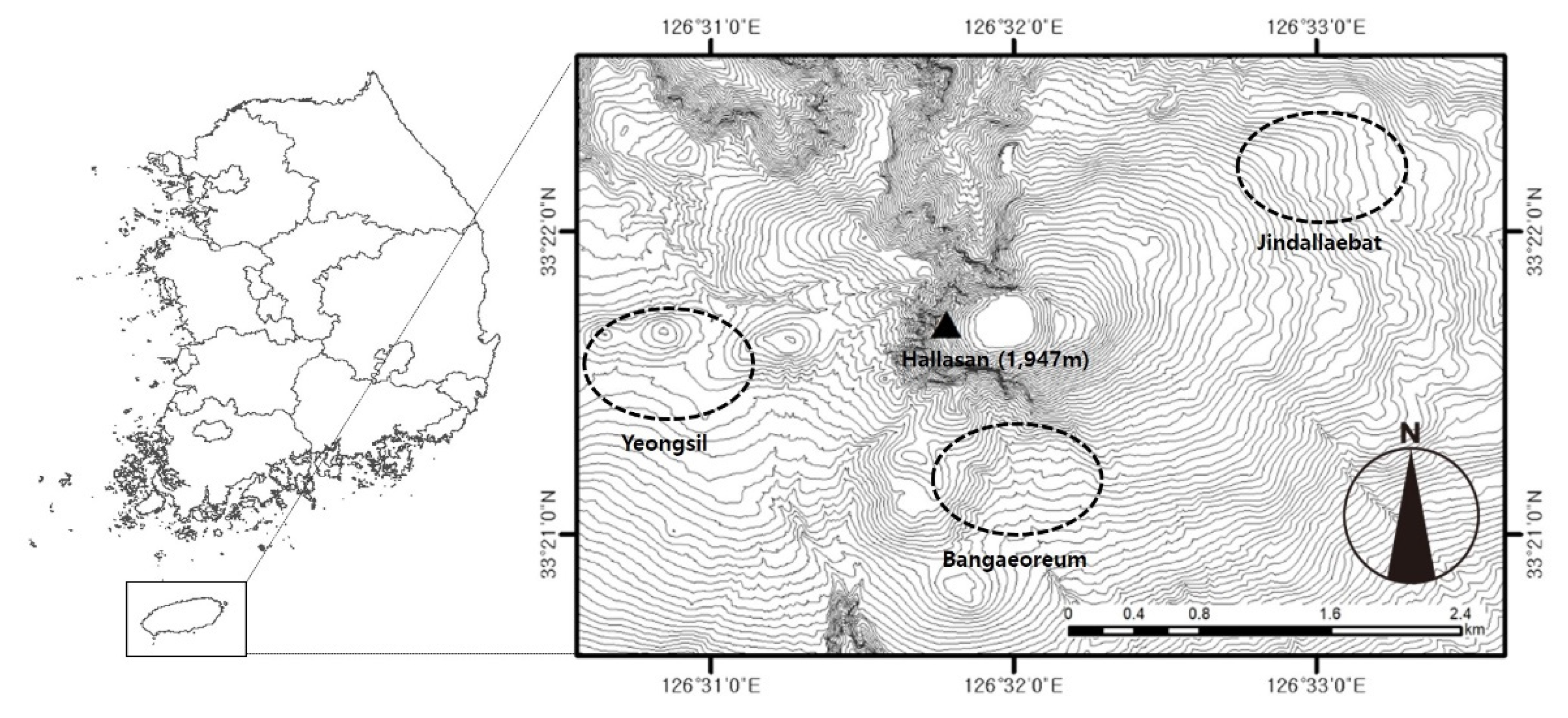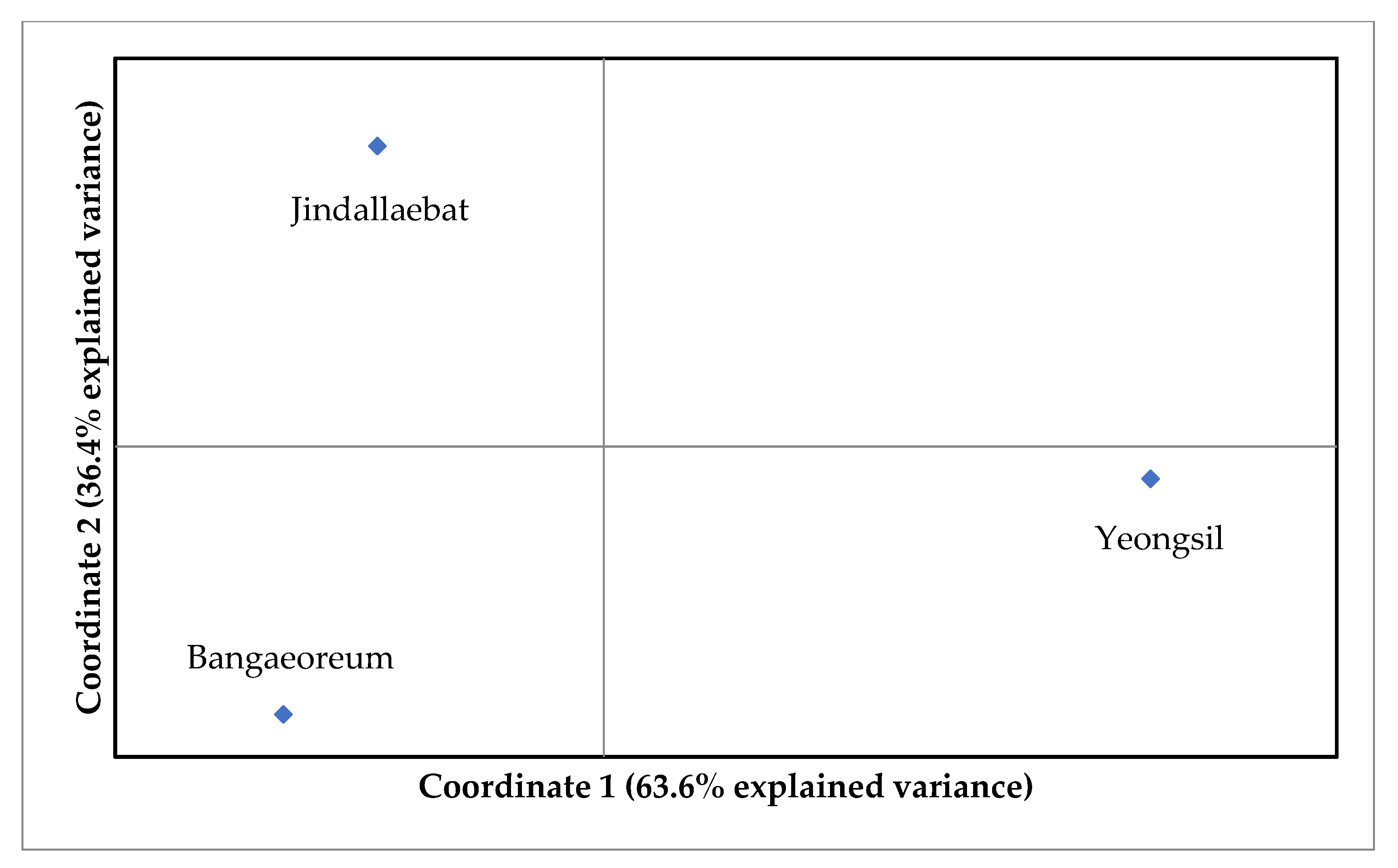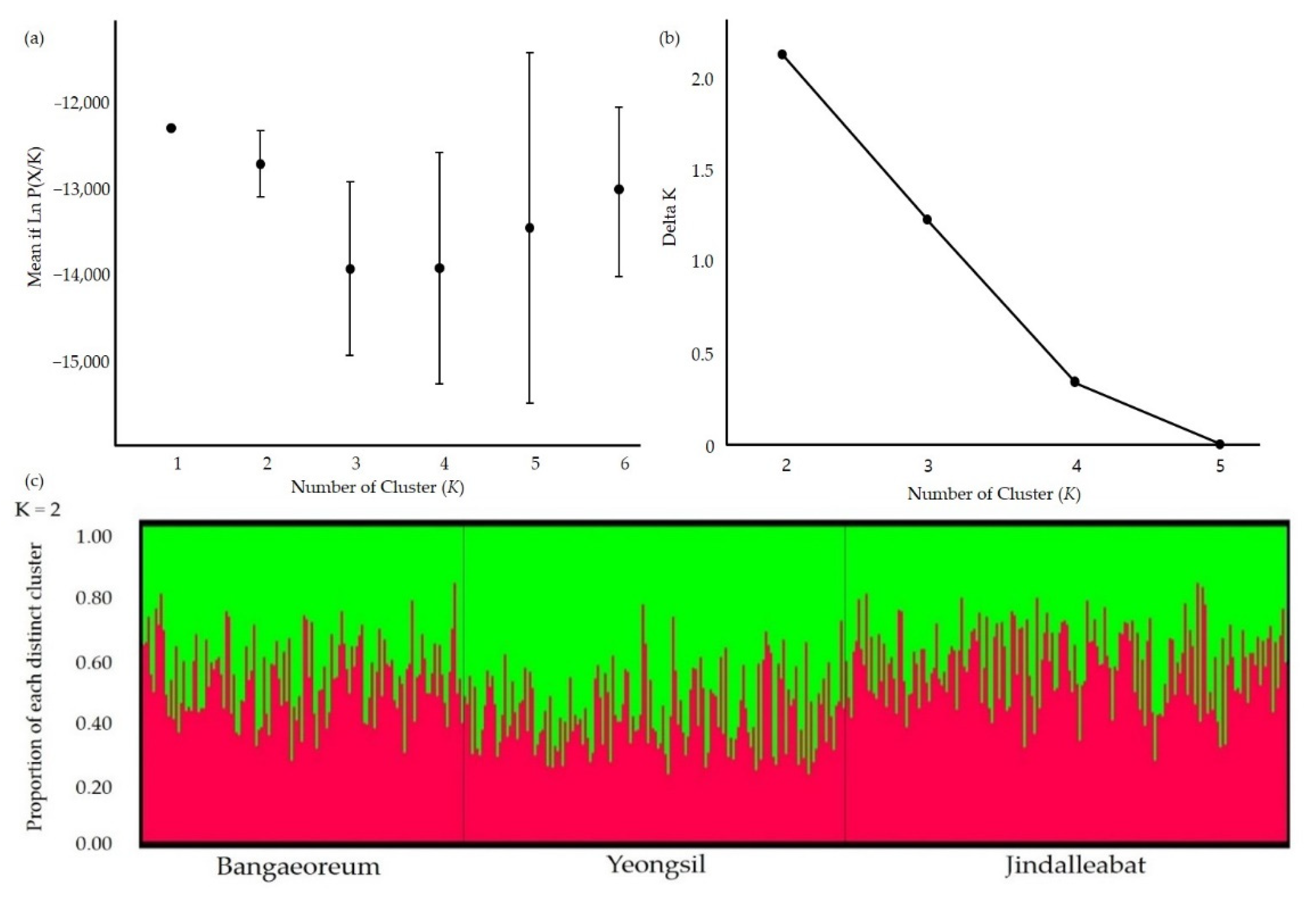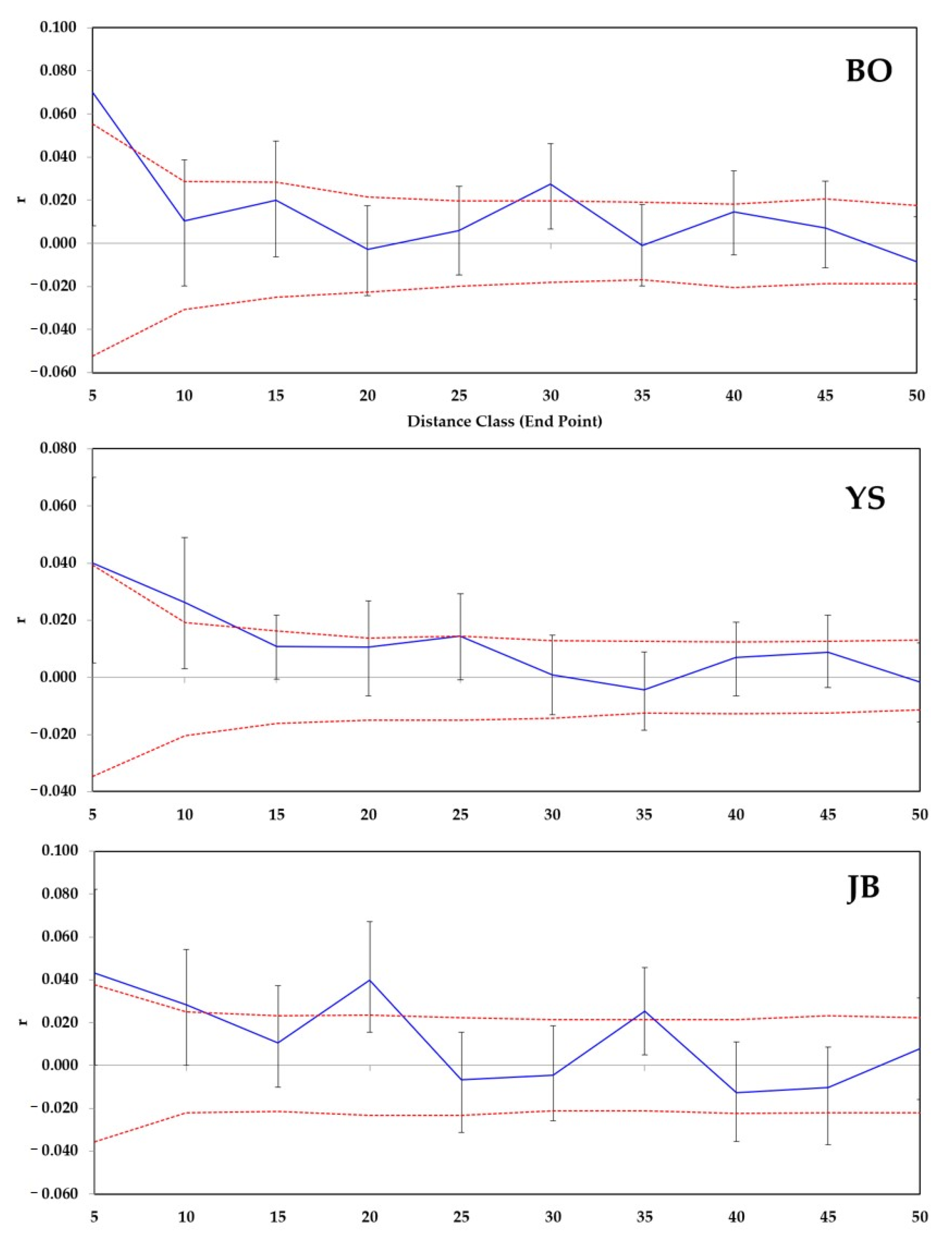Selection of Restoration Material for Abies koreana Based on Its Genetic Diversity on Mt. Hallasan
Abstract
:1. Introduction
2. Materials and Methods
2.1. Study Sites
2.2. DNA Extraction, Amplification, and Sizing
2.3. Genetic Data Analysis
2.4. Spatial Genetic Structure Analysis
2.5. Comparison between Sampling Strategies
3. Results
3.1. Genetic Diversity
3.2. Spatial Genetic Structure
3.3. Sample Size
4. Discussion
5. Conclusions
Author Contributions
Funding
Data Availability Statement
Acknowledgments
Conflicts of Interest
References
- FAO. Global Plan of Action for the Conservation, Sustainable Use and Development of Forest Genetic Resources; Food and Agriculture Organization of the United Nations: Rome, Italy, 2014; p. 31. [Google Scholar]
- Potts, B.M.; Barbour, R.C.; Hingston, A.B.; Vaillancourt, R.E. Genetic pollution of native eucalypt gene pools—Identifying the risks. Aust. J. Bot. 2003, 51, 1–25. [Google Scholar] [CrossRef]
- Bischoff, A.; Steinger, T.; Müller-Schärer, H. The Importance of Plant Provenance and Genotypic Diversity of Seed Material Used for Ecological Restoration. Restor. Ecol. 2008, 18, 338–348. [Google Scholar] [CrossRef]
- McKay, J.K.; Christian, C.E.; Harrison, S.; Rice, K.J. “How Local Is Local?”—A Review of Practical and Conceptual Issues in the Genetics of Restoration. Restor. Ecol. 2005, 13, 432–440. [Google Scholar] [CrossRef]
- Lande, R.; Shannon, S. The role of genetic variation in adaptation and population persistence in a changing environment. Evolution 1996, 50, 434–437. [Google Scholar] [CrossRef] [PubMed]
- Reed, D.H.; Frankham, R. Correlation between Fitness and Genetic Diversity. Conserv. Biol. 2003, 17, 230–237. [Google Scholar] [CrossRef]
- Hong, S.C.; Lee, Y.W. Ecological studies on the vegetational characteristics of the Abies koreana forest. J. Korean Soc. Forest Sci. 1995, 84, 247–257. [Google Scholar]
- Lim, J.H.; Kim, E.S.; Park, G.E.; Kim, Y.S.; Jang, K.C.; Han, J.G.; Jung, S.C.; Lim, H.I.; Lee, B.R.; Song, W.K.; et al. Status and Conservation of Endangered Sub-Alpine Conifer Species in Korea; National Institute of Forest Science: Seoul, Korea, 2019. [Google Scholar]
- Kim, Y.-S.; Chang, C.-S.; Kim, C.-S.; Gardner, M. Abies koreana. The IUCN Red List Threat. Species 2011, 2011, e.T31244A9618913. [Google Scholar] [CrossRef]
- Kong, W.S. Species composition and distribution of Korean alpine plants. J. Korean Geogr. Soc. 2002, 37, 357–370. [Google Scholar]
- KNPS. 2009. Available online: http://www.knps.or.kr/ (accessed on 10 September 2021).
- Hallasan National Park. 2009. Available online: http://www.hallasan.go.kr/ (accessed on 10 September 2021).
- UNESCO Korea. 2009. Available online: http://www.unesco.or.kr/ (accessed on 10 September 2021).
- UNESCO World Heritage Center. 2009. Available online: http://whc.unesco.org (accessed on 10 September 2021).
- Kim, J.-K.; Koh, J.-G.; Yim, H.-T.; Kim, D.-S. Changes of Spatial Distribution of Korean fir Forest in Mt. Hallasan for the Past 10 Years (2006, 2015). Korean J. Environ. Ecol. 2017, 31, 549–556. [Google Scholar] [CrossRef]
- Seo, J.-W.; Choi, E.-B.; Park, J.-H.; Kim, Y.-J.; Lim, H.-I. The Role of Aging and Wind in Inducing Death and/or Growth Reduction in Korean Fir (Abies koreana Wilson) on Mt. Halla, Korea. Atmosphere 2021, 12, 1135. [Google Scholar] [CrossRef]
- Shin, Y.-M.; Nam, J.-W.; Kim, D.-K.; Byun, B.-K.; Kim, I.-K. Two lepidopteran pests and damage on the cones of Abies koreana (Pinaceae) in Jeju Island, Korea. J. Asia-Pac. Biodivers. 2018, 11, 80–86. [Google Scholar] [CrossRef]
- Weir, B.S. Genetic Data Analysis; Sinauer Associates: Sunderland, UK, 1990. [Google Scholar]
- Brown, A.D.H.; Marshall, D.R. A Basic Sampling Strategy: Theory and Practice. Collecting Plant Genetic Diversity [Technical Guidelines]; CABI Publishing: Wallingford, UK, 1995; pp. 75–91. [Google Scholar]
- Williams, C.G.; Hamrick, J. Elite populations for conifer breeding and gene conservation. Can. J. For. Res. 1996, 26, 453–461. [Google Scholar] [CrossRef]
- Smouse, P.E.; Peakall, R. Spatial autocorrelation analysis of individual multiallele and multilocus genetic structure. Heredity 1999, 82, 561–573. [Google Scholar] [CrossRef] [PubMed] [Green Version]
- Nettel, A.; Dodd, R.S.; Afzal-Rafii, Z. Genetic diversity, structure, and demographic change in tanoak, Lithocarpus densiflorus (Fagaceae), the most susceptible species to sudden oak death in California. Am. J. Bot. 2009, 96, 2224–2233. [Google Scholar] [CrossRef] [PubMed] [Green Version]
- Postolache, D.; Leonarduzzi, C.; Piotti, A.; Spanu, I.; Roig, A.; Fady, B.; Roschanski, A.; Liepelt, S.; Vendramin, G.G. Transcriptome versus genomic microsatellite markers: Highly informative multiplexes for genotyping Abies alba Mill and congeneric species. Plant Mol. Biol. Rep. 2014, 32, 750–760. [Google Scholar] [CrossRef]
- Hansen, O.K.; Vendramin, G.G.; Sebastiani, F.; Edwards, K.J. Development of microsatellite markers in Abies nordmanniana (Stev.) Spach and cross-species amplification in the Abies genus. Mol. Ecol. Notes 2005, 5, 784–787. [Google Scholar] [CrossRef]
- Uchiyama, K.; Fujii, S.; Ishizuka, W.; Goto, S.; Tsumura, Y. Development of 32 EST-SSR markers for Abies firma (Pinaceae) and their transferability to related species. Appl. Plant Sci. 2013, 1, 1200464. [Google Scholar] [CrossRef]
- Van Oosterhout, C.; Hutchinson, W.F.; Wills, D.P.M.; Shipley, P.F. MICRO-CHECKER: Software for identifying and correcting genotyping errors in microsatellite data. Mol. Ecol. Notes 2004, 4, 535–538. [Google Scholar] [CrossRef]
- Peakall, R.; Smouse, P.E. GenAlEx 6.5: Genetic analysis in Excel. Population genetic software for teaching and research—An update. Bioinformatics 2012, 28, 2537–2539. [Google Scholar] [CrossRef] [Green Version]
- Goudet, J. FSTAT Program to Estimate and Test Gene Diversities and Fixation Indices (Version 2.9.4). 2002. Available online: http://www2.unil.ch/popgen/softwares/fstat.html (accessed on 10 September 2021).
- Pritchard, J.K.; Stephens, M.; Donnelly, P. Inference of population structure using multilocus genotype data. Genetics 2000, 155, 945–959. Available online: http://www.ncbi.nlm.nih.gov/pubmed/10835412 (accessed on 9 December 2021). [CrossRef]
- Evanno, G.; Regnaut, S.; Goudet, J. Detecting the number of clusters of individuals using the software structure: A simulation study. Mol. Ecol. 2005, 14, 2611–2620. [Google Scholar] [CrossRef] [Green Version]
- Earl, D.A.; von Holdt, B.M. STRUCTURE HARVESTER: A website and program for visualizing STRUCTURE output and implementing the Evanno method. Conserv. Genet. Resour. 2012, 4, 359–361. [Google Scholar] [CrossRef]
- Jakobsson, M.; Rosenberg, N.A. CLUMPP: A cluster matching and permutation program for dealing with label switching and multimodality in analysis of population structure. Bioinformatics 2007, 23, 1801–1806. [Google Scholar] [CrossRef] [Green Version]
- Rosenberg, N.A. Distruct: A program for the graphical display of population structure. Mol. Ecol. Notes 2004, 4, 137–138. [Google Scholar] [CrossRef]
- De Mendiburu, F.; Simon, R. Agricolae—Ten years of an open source statistical tool for experiments in breeding, agriculture and biology. PeerJ PrePrints 2015, 3, e1404v1. [Google Scholar]
- Ahn, J.Y.; Lim, H.I.; Ha, H.W.; Han, J.; Han, S.H. Genetic variation of Korean fir subpopulations in Mt. Jiri for the restoration of genetic diversity. J. Korean Soc. Forest Sci. 2017, 106, 417–423. [Google Scholar]
- Lim, H.I.; Chae, S.B.; Kim, K.T. Genetic considerations for selecting the seedlings to restore a small population of Abies koreana, an endangered fir species that is endemic to Korea. Fores. Res. 2020, 9, 241. [Google Scholar]
- Janes, J.K.; Miller, J.M.; Dupuis, J.R.; Malenfant, R.M.; Gorrell, J.C.; Cullingham, C.I.; Andrew, R.L. The K = 2 conundrum. Mol. Ecol. 2017, 26, 3594–3602. [Google Scholar] [CrossRef] [PubMed] [Green Version]
- Cullingham, C.I.; Miller, J.M.; Peery, R.M.; Dupuis, J.R.; Malenfant, R.M.; Gorrell, J.C.; Janes, J.K. Confidently identifying the correct K value using the ΔK method: When does K = 2? Mol. Ecol. 2020, 29, 862–869. [Google Scholar] [CrossRef]




| No. | Subpopulation | Sample Size | Height (m) | DBH (cm) | Geographic Location | ||
|---|---|---|---|---|---|---|---|
| Latitude | Longitude | Altitude (m) | |||||
| 1 | Bangaeoreum | 128 | 3.9 | 17.4 | 126°31.0′ | 33°21.3′ | 1610–1646 |
| 2 | Yeongsil | 152 | 3.6 | 17.3 | 126°30.5′ | 33°21.6′ | 1652–1663 |
| 3 | Jindallaebat (Azalea Field) | 176 | 5.0 | 22.7 | 126°33.3′ | 33°22.1′ | 1493–1551 |
| No. | Primer | Primer (5′–3′) | Repeat motif | Reference |
|---|---|---|---|---|
| 1 | Aag02 | F: TATTCCTCCACTTGGGTGCT | (GA)13 | [23] |
| R: GGTGGAGATCCGTATGCAAT | (Abies alba) | |||
| 2 | Aat04 | F: CCATGTATGGTGCTCCTCCT | (CAG)11 | [23] |
| R: CCTTCATTGCAGAAAAGCAA | (A. alba) | |||
| 3 | Aat05 | F: AGCATCCACATTCCGTAACC | (GCA)7 | [23] |
| R: AGTTGACCGTTGGAGAGCAG | (A. alba) | |||
| 4 | Aat12 | F: ATCCATATCTCCTGCCTTGC | (AG)12 | [23] |
| R: CTTTCCAGGTGATCTGATTGC | (A. alba) | |||
| 5 | Aat15 | F: AGGAGGAGGTTCAGCATGTC | (AGA)8 | [23] |
| R: CTTGCTCTCTGACCCAGTTG | (A. alba) | |||
| 6 | SF83 | F: AGCAGCATAACCAAGGGTCAA | (CTT)3…(GCC)5 | [23] |
| R: TCTGAATTTCTAAAGGCGGC | (A. alba) | |||
| 7 | NFF07 | F: CCCAAACTGGAAGATTGGAC | (GA)33 | [24] |
| R: ATCGCCATCCATCATCAGA | (A. nordmanniana) | |||
| 8 | NFF15 | F: CGCCTCCCTCCATTACTTC | (AC)15 | [24] |
| R: TCGTCTAGAGAGGCGAAATTCT | (A. nordmanniana) | |||
| 9 | C49 | F: GACGAAGATCAGTACAAGGCACGA | (AGGAGA)7 | [25] |
| R: GCGATCCTTCAATTTGTCCTTCTC | (A. firma) | |||
| 10 | C28104 | F: CGAGGAAGAAGCCAAGTTATCAGG | (ATA)5 | [25] |
| R: CACAGTTAAAAAGGCGGCCTACAG | (A. firma) |
| Subpopulation | A | Ae | Ho | He | FIS | |
| Bangaeoreum | Mean | 6.8 | 3.8 | 0.480 | 0.591 | 0.136 *** |
| SE | 1.8 | 1.0 | 0.066 | 0.078 | 0.076 | |
| Yeongsil | Mean | 7.0 | 3.6 | 0.527 | 0.595 | 0.071 *** |
| SE | 1.7 | 0.7 | 0.062 | 0.076 | 0.058 | |
| Jindalleabat | Mean | 7.5 | 4.3 | 0.589 | 0.619 | 0.015 *** |
| (Azalea Field) | SE | 2.0 | 1.1 | 0.076 | 0.083 | 0.065 |
| Mt. Hallasan | Mean | 8.0 | 4.2 | 0.538 | 0.614 | 0.083 *** |
| SE | 2.1 | 1.0 | 0.065 | 0.079 | 0.059 |
| Source | Degrees | Sum | Mean | Estimated | Percent | p |
|---|---|---|---|---|---|---|
| of Freedom | of Squares | Squares | Variation | of Variation | ||
| Among subpopulations | 2 | 100.133 | 50.066 | 0.287 | 4% | 0.001 |
| Within subpopulations | 453 | 3099.492 | 6.842 | 6.842 | 96% | - |
| Total | 455 | 3199.625 | 7.129 | 100% | - |
| Subpopulation | Bangaeoreum | Yeongsil | Jindalleabat |
|---|---|---|---|
| Bangaeoreum | - | 0.016 *** | 0.010 *** |
| Yeongsil | 0.050 | - | 0.013 *** |
| Jindalleabat | 0.031 | 0.046 | - |
| Subpopulation | No. of Samples | ||||||||||||||
| 5 | 10 | 15 | 20 | 25 | 30 | 35 | 40 | ||||||||
| Bangaeoreum (%) | 70 ± 3.9 e | 89 ± 3.0 d | 93 ± 5.3 c | 95 ± 3.6 bc | 98 ± 1.6 ab | 99 ± 1.2 a | 100 a | 100 a | |||||||
| Yeongsil (%) | 73 ± 4.6 d | 86 ± 5.6 c | 93 ± 5.5 b | 97 ± 2.8 a | 99 ± 2.8 a | 99 ± 1.2 a | 100 a | 100 a | |||||||
| Jindalleabat (%) | 75 ± 3.6 e | 90 ± 4.0 d | 95 ± 4.4 c | 97 ± 2.1 bc | 98 ± 2.1 ab | 100 a | 100 a | 100 a | |||||||
| Population | No. of Samples | ||||||||||||||
| 9 | 15 | 24 | 30 | 39 | 45 | 60 | 69 | 75 | 84 | 90 | 99 | 105 | 114 | 120 | |
| Mt. Hallasan (%) | 87 ± 6.0 c | 95 ± 1.6 b | 98 ± 2.8 ab | 100 a | 100 a | 100 a | 100 a | 100 a | 100 a | 100 a | 100 a | 100 a | 100 a | 100 a | 100 a |
Publisher’s Note: MDPI stays neutral with regard to jurisdictional claims in published maps and institutional affiliations. |
© 2021 by the authors. Licensee MDPI, Basel, Switzerland. This article is an open access article distributed under the terms and conditions of the Creative Commons Attribution (CC BY) license (https://creativecommons.org/licenses/by/4.0/).
Share and Cite
Chae, S.-B.; Lim, H.-I.; Kim, Y.-Y. Selection of Restoration Material for Abies koreana Based on Its Genetic Diversity on Mt. Hallasan. Forests 2022, 13, 24. https://doi.org/10.3390/f13010024
Chae S-B, Lim H-I, Kim Y-Y. Selection of Restoration Material for Abies koreana Based on Its Genetic Diversity on Mt. Hallasan. Forests. 2022; 13(1):24. https://doi.org/10.3390/f13010024
Chicago/Turabian StyleChae, Seung-Beom, Hyo-In Lim, and Yong-Yul Kim. 2022. "Selection of Restoration Material for Abies koreana Based on Its Genetic Diversity on Mt. Hallasan" Forests 13, no. 1: 24. https://doi.org/10.3390/f13010024





